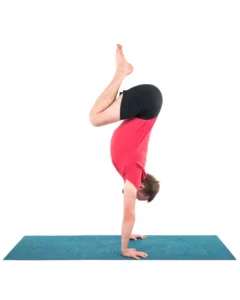Diaphragmatic Breathing for Healthy Aging

You’ve seen them. The people in church or at a concert enthusiastically sing along, their shoulders rising each time they take a deep breath. While they believe raising their shoulders enables them to take a deep, full breath, nothing is further than the truth. Using the shoulders, upper chest, neck, and back muscles to inhale creates a shallow and rapid chest breathing pattern. To truly breathe deeply and fully, you must use your main breathing muscle, the diaphragm. Unlike diaphragmatic breathing (sometimes referred to as “belly breathing“), shallow chest breathing results in higher blood pressure, increased heart rate, muscle tension, higher stress levels, and feelings of fatigue.
Studies of vital lung capacity, or our ability to breathe deeply, show that lung capacity is a reliable predictor of mortality. To understand this better, let’s examine how aging affects the lungs and how yogic breathing helps maintain vital lung capacity.
Breath and Aging
Breathing is vital for health. However, as we age, our ability to breathe properly starts to diminish. In addition to loss of elasticity in the lungs and intercostal muscles (located between the ribs), stiffening of the ribcage limits our ability to breathe deeply. Factors such as prolonged sitting, poor posture, increased stress, and chronic pain also affect breathing.
As a result, it is common for the lungs to lose about 12 percent of their capacity between the ages of 30 and 50. In fact, by age 80, lung capacity can be diminished by up to 30 percent. To better understand why this happens, let’s look at how our lungs do the work of breathing.
How the Lungs Work
First, our lungs don’t have muscular tissue so we can’t move them voluntarily. Instead, the lungs rely on the muscles of the diaphragm, rib cage, and abdomen. Further, the expansion and shrinking of the lungs occurs in response to the interplay between the following: 1) pressure and volume within the lungs, 2) the pleural cavity that separates the lungs from the ribcage, and 3) the atmospheric pressure around you.
Here’s how these three things work together to facilitate breathing:
First, when you inhale, the diaphragm contracts and moves downward. This increases the space in the chest cavity, allowing the lungs to expand into it.
Then, the intercostal muscles between the ribs help enlarge the chest cavity by contracting to pull the rib cage both upward and outward on an inhalation. This ability of the lungs to stretch out following the movement of the ribcage is called lung compliancy.
Next, as the lungs expand, the air pressure inside the lungs decreases, causing atmospheric air to fill the lungs.
Lung Compliancy and Lung Elasticity
When you reach the end of an inhalation, elastic fibers in the lungs cause them to recoil, or shrink back, pulling the ribcage inward. During this process, muscles attached to the ribs contract and the muscles of the diaphragm and the abdomen relax. As a result, volume in the chest cavity decreases and pressure in the lungs increases, causing the air to be pushed out through the nose. This ability of the lungs to recoil is called lung elasticity.
Proper lung function depends on the delicate balance between lung compliancy (ability to stretch out) and lung elasticity (ability to shrink back). Yoga can support healthy lung function in this area.
“For breath is life, so if you breathe well, you will live long on earth.”
~Sanskrit Proverb
Yoga and Healthy Lungs

Yoga practices can help maintain the proper balance of compliancy and elasticity of the lungs in several ways.
- Moving the spine in all directions. From backbends to forward folds, twists, side bends, and general lengthening, movement of the spine in all directions serves to maintain spinal mobility and the elasticity of the intercostal muscles. In particular, backbends counteract the rounding of the upper spine, known as kyphosis, that often comes with age.
- Breathing fully. Deepening the inhalation and lengthening the exhalation increases lung elasticity and compliancy. Pranayama practices, like three-part breath (dirgha swasam), encourage the use of the entirety of the lungs, not just the upper regions.
- Working with Breath Retention. The breath is divided into four parts: 1) the inhalation, 2) the brief pause before the next exhalation, 3) the exhalation, and 4) the pause that proceeds the next inhalation. By working with specific proportional breath ratios, we can increase the amount of time we are able to suspend the breath and thus increase lung capacity.
Simple Breath Ratio Practice

If you’d like to give ratio breathing a try, here’s how:
- Begin with an easy, unhurried 3 to 4-count inhalation.
- At the end of your inhalation, pause for a count of one or two. This should feel comfortable and effortless.
- Exhale slowly, making your exhalation one to two counts longer than the inhalation. For example, if you inhaled for a count of three, your exhalation should be about 4 to 5 counts in length.
- Pause again at the end of your exhalation for 1 to 2 counts before taking your next inhalation.
- Continue this pattern for 5 to 10 breath cycles.
- Finish by returning to your normal breath pattern for a few cycles. Notice any after-effects from this practice.
Note: With the guidance of an experienced yoga teacher or therapist, you can learn how to gradually increase these ratios and improve your lung capacity.
Also, read...
Diaphragmatic Breathing for Healthy Aging
Dec 13 – Beverly Davis-Baird, MA, e-RYT200/RYT 500, C-IAYT
5 Reasons Your Immune System Gets Weaker with Age and How Yoga Can Help
Dec 06 – By: Nina Zolotow, RYT 500
Is Yoga for Hypertension Effective?
Oct 05 – Leah Sugerman, E-RYT 500, YACEP
Related courses
Breath as Medicine: Yogic Breathing for Vital Aging
With Doug Keller
Yoga and Myofascial Release: Releasing Chronic Tension with the Bodymind Ballwork Method
With Ellen Saltonstall

Beverly Davis-Baird, MA, e-RYT200/RYT 500, C-IAYT is a New Jersey-based yoga therapist, writer, and educator. She specializes in making yoga accessible for adults 50+, offering classes and workshops for back care, arthritis, bone health, balance, posture, and healthy aging. An educator at heart with over 20 years of experience as a public school teacher, Beverly brings her knowledge of individual learning styles to her classes, providing instruction that is clear, concise, inclusive, and compassionate. Bringing over 30 years of experience and training, she considers herself a lifelong learner and believes that the practice of yoga should bring spaciousness and release from tension, not create it. As such, she strives to make yoga accessible to people of differing abilities, believing the real benefits of yoga come from what is taken with you outside of class and into your life. To read her blog or learn more about her teaching schedule and latest offerings, please visit www.wisdomtreeyoga.com.
Recent articles
4 Ways to Practice Locust Pose
Jun 26 – Baxter Bell, MD, eRYT 500, C-IAYT
The Yoga Sutras: Practicing Non-Attachment without Becoming Detached
Jun 24 – By: Tracy Weber, C-IAYT, E-RYT 500
4 Easy Ways to Use a Sandbag in Yoga Practice
Jun 18 – Jennifer Williams-Fields E-RYT 200
Categories
Upcoming courses
Breath as Medicine: Yogic Breathing for Vital Aging
With Doug Keller
Yoga and Myofascial Release: Releasing Chronic Tension with the Bodymind Ballwork Method
With Ellen Saltonstall
JOIN NOW!
Recent articles
Almost there...
Sorry, we couldn't find anything...
Pose Library
4 Ways to Practice Locust Pose
Locust Pose (Salabhasana) is a simple backbend that strengthens the entire back of your…
Jun 26 – Baxter Bell, MD, eRYT 500, C-IAYT
Beginning Yoga
The Yoga Sutras: Practicing Non-Attachment without Becoming Detached
The concepts of attachment and non-attachment are mentioned several times in The Yoga Sutras…
Jun 24 – By: Tracy Weber, C-IAYT, E-RYT 500
Yoga Practice Tips
4 Easy Ways to Use a Sandbag in Yoga Practice
B.K.S. Iyengar is credited with introducing props into modern yoga as a means of…
Jun 18 – Jennifer Williams-Fields E-RYT 200




